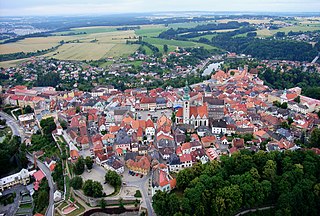
Tábor is a town in the South Bohemian Region of the Czech Republic. It has about 33,000 inhabitants. The town centre is well preserved and is protected by law as an urban monument reservation.

Vyšehrad is a historic fort in Prague, Czech Republic, just over 3 km southeast of Prague Castle, on the east bank of the Vltava River. It was probably built in the 10th century. Inside the fort are the Basilica of St. Peter and St. Paul and the Vyšehrad Cemetery, containing the remains of many famous Czechs, such as Antonín Dvořák, Bedřich Smetana, Karel Čapek, and Alphonse Mucha. It also contains Prague's oldest Rotunda of St. Martin, from the 11th century.

Břeclav is a town in the South Moravian Region of the Czech Republic. It has about 24,000 inhabitants.
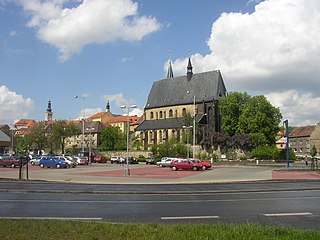
Slaný is a town in Kladno District in the Central Bohemian Region of the Czech Republic. It has about 16,000 inhabitants. The historic town centre is well preserved and is protected by law as an urban monument zone.

Třebíč is a town in the Vysočina Region of the Czech Republic. It has about 34,000 inhabitants.

Prostějov is a city in the Olomouc Region of the Czech Republic. It has about 43,000 inhabitants. The city is known for its fashion industry. The historical city centre is well preserved and is protected by law as an urban monument zone.

Kadaň is a town in Chomutov District in the Ústí nad Labem Region of the Czech Republic. It has about 18,000 inhabitants. It lies on the banks of the river Ohře. Kadaň is a tourist centre with highlights being the Franciscan Monastery and the historical square with late Gothic Town Hall Tower. The town centre is well preserved and is protected by law as an urban monument reservation.

The Franciscan Monastery lies on the edge of the town of Kadaň, Czech Republic and near the river Ohře. Its history dates back to the 15th century. It is now the seat of the Municipal Museum of Kadaň with an exposition of life in a monastery. The church's dedication to the Fourteen Holy Helpers shows the connection to then popular German shrines of the same cult. Around the building is a beautiful vineyard, a French park and many plum trees. The monastery was ranked among the national cultural monuments by the Ministry of Culture of the Czech Republic in 1995. The monastery faces the Úhošť hill on the opposite slope of the Ohře valley.

The Church of the Assumption of the Buda Castle, more commonly known as the Matthias Church, more rarely the Coronation Church of Buda, is a Roman Catholic church located in the Holy Trinity Square, Budapest, Hungary, in front of the Fisherman's Bastion at the heart of Buda's Castle District. According to church tradition, it was originally built in Romanesque style in 1015, although few references exist. The current building was constructed in the florid late Gothic style in the second half of the 14th century and was extensively restored in the late 19th century. It was the second largest church of medieval Buda and the seventh largest church of the medieval Hungarian Kingdom.

Moravský Krumlov is a town in Znojmo District in the South Moravian Region of the Czech Republic. It has about 5,600 inhabitants. The historic town centre is well preserved and is protected by law as an urban monument zone.
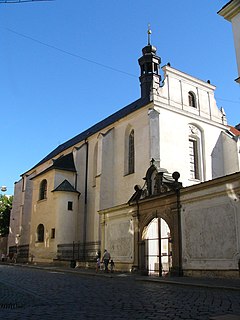
The Monastery of St. Catherine in Olomouc, Czech Republic, was founded in 1287 for a community of Dominican nuns, who occupied it until 1782, when it passed over to the Ursuline nuns. The Ursuline Order remained in the monastery until 1951, when it was suppressed and converted to secular use under the Communist regime. It has been since used by the Regional Museum of Olomouc.
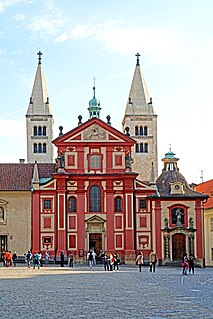
St. George's Basilica is the oldest surviving church building within Prague Castle, Prague, Czech Republic. The basilica was founded by Vratislaus I of Bohemia in 920. It is dedicated to Saint George. Primarily Romanesque in style, it is part of the collection of buildings that comprise the castle, the political capital of the nation, and the spiritual center of the Czech state.

The Moravian Gallery in Brno is the second largest art museum in the Czech Republic, established in 1961 by merging of two older institutions. It is situated in five buildings: Pražák Palace, Governor's Palace, Museum of Applied Arts, Jurkovič House and Josef Hoffmann Museum. Since 1963 the gallery has organized the International Biennial of Graphic Design Brno.

The Cathedral of Saints Peter and Paul is a Roman Catholic cathedral located on the Petrov hill in the Brno-střed district of the city of Brno in the Czech Republic. It is commonly referred to locally as simply "Petrov". It is the seat of the Diocese of Brno and a national cultural monument that is one of the most important pieces of architecture in South Moravia. The interior is mostly Baroque in style, while the exterior shell is Gothic that dates mostly from the 14th century, and its impressive 84-metre-high towers were constructed to the Gothic Revival designs of the architect August Kirstein between 1901–09. The original cathedral site dates to the 11th century.
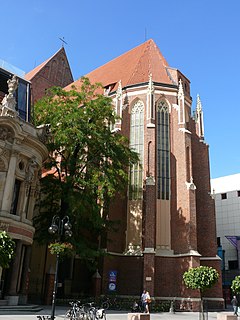
The Church of Sts. Dorothea, Wenceslaus, and Stanislaus,, is a Roman Catholic Church in the southern part Wrocław's Old Town.

Czech Gothic architecture refers to the architectural period primarily of the Late Middle Ages in the area of the present-day Czech Republic.

Czech Renaissance architecture refers to the architectural period of the early modern era in Bohemia, Moravia and Czech Silesia, which then comprised the Crown of Bohemia and today constitute the Czech Republic. The Renaissance style flourished in the Czech lands from the late 15th century to the first half of the 17th century.

The Basilica of the Assumption of Our Lady in Old Brno Abbey is a high Gothic, monumental convent temple. It was founded in 980-1020 by the unknown lord or monarch in Moravia. It was built on the site of an ancient sanctuary from the late 10th century in a short time in the years 1323 to 1334 at the instigation of Queen Elizabeth Richeza. It is the best preserved stylistically coherent and unified temple in Lands of Bohemian crown.

The Franciscan Monastery is located near the Main Square in Plzeň, Czech Republic. Originally belonging to the Minorites, the later Franciscan monastery was founded at the end of the 13th century. The Church of the Assumption of the Virgin Mary, Chapterhouse and Chapel of St. Barbara also belong to the monastery complex.
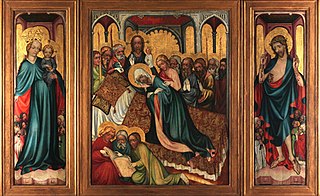
The Roudnice Altarpiece is a three-part winged altar from the provost's church in Roudnice nad Labem, one of the oldest completely preserved Gothic retables from the period around 1410-1420. It is on display in the permanent exhibition of the National Gallery in Prague.





























































